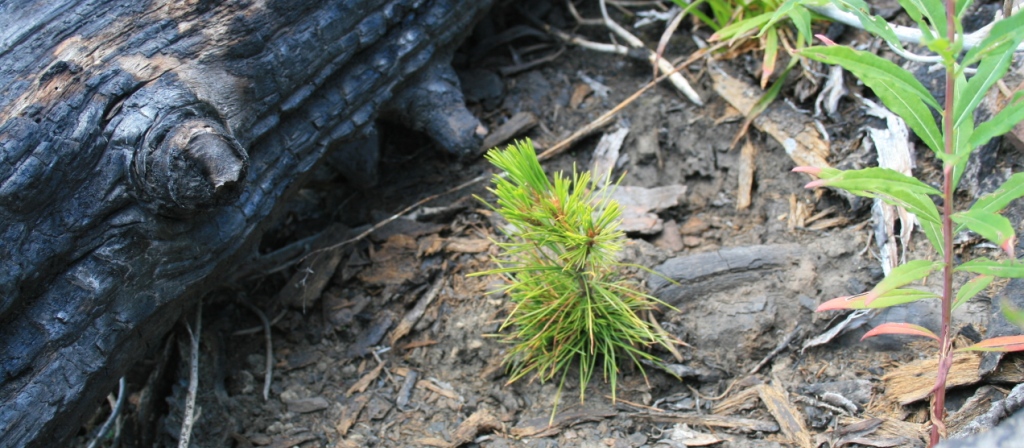One Project at a Time
A partnership between the Whitebark Pine Ecosystem Foundation (WPEF) and US Forest Service Forest Health Protection (FHP) to provide information on completed or on-going projects leading to the restoration of whitebark pine ecosystems.
Whitebark Pine Restoration Project Photos
HISTORY
The US Forest Service, Forest Health Protection (FHP) Whitebark Pine Restoration Program was developed in 2006 under the leadership of former FHP Director Dr. Robert Mangold—the first and only restoration program with dedicated funding for whitebark pine. The initiative resulted in part from dialogue with the Whitebark Pine Ecosystem Foundation (WPEF), followed by the appointment of FHP forest pathologist Dr. John Schwandt to compile a health assessment of whitebark pine communities. Similar assessments were underway in Canada. All information pointed to a dramatic decline in whitebark pine health, primarily caused by white pine blister rust (Cronartium ribicola) introduced a century earlier, plus a growing outbreak of native mountain pine beetles (Dendroctonus ponderosae), but also fire suppression leading to successional replacement of whitebark pine. The downward trend for whitebark pine continues, with several regions showing significant health deterioration. In 2011, the U.S. Fish and Wildlife Service declared whitebark pine a priority Candidate species for listing under the Endangered Species Act.
PURPOSE OF THE WEBSITE
This website provides information for projects funded by the FHP Whitebark Pine Restoration Program, arranged by year. Each report follows a similar format that concisely communicates the objectives and outcome with detailed information available as separate files. These examples, which include contact information, provide support for agencies or non-profits interested in initiating their own restoration projects. We also recommend an important resource for visitors to this website: Basic restoration techniques are described in Keane et al. [2012, A range-wide restoration strategy for whitebark pine (Pinus albicaulis), RMRS-GTR-279, http://www.treesearch.fs.fed.us/pubs/40884], which also outlines procedures for developing sound restoration projects.
ACCOMPLISHMENTS
Under John Schwandt, the founding manager, and now Christy Cleaver (FHP, Region 1) and Sky Stephens, the Whitebark Pine Restoration Program has supported all aspects of restoration including development of strategic plans, gene conservation, health surveys, silvicultural treatments, cone collections, seedling planting, and public outreach efforts.
As of 2023, the program received 720 proposals requesting $14.2 million in funding. Proposal categories are Assessing Health: Survey and Monitoring, Operational Cone Collections, Harnessing Rust Resistance, Enhancing Regeneration and Reducing Competitive Regeneration, Special Projects, and Outreach/Education/Technology transfer. Proposals are reviewed and ranked each year by an interagency Technical Committee. Although requests far outweigh available funding, FHP has provided $4,349,215 to fund 371 of these proposals with a total value of more than $12,485,000, including additional funding and matching contributions. Projects have been implemented across the range of whitebark pine and in lands under the jurisdiction of several federal agencies.
COOPERATORS
The past success of the program may be attributed to support by many cooperators and partners, more than doubling the FHP funding levels. These include state and private agencies, foundations, and universities as well as over 30 National Forests across 5 Regions, and 10 National Parks. The Whitebark Pine Restoration Program received the Region-1 Regional Forester’s Natural Resources Stewardship Award in 2009. In addition, other Regions of the USFS, various U.S. National Parks, and several provincial agencies and non-profits in Canada have implemented restoration projects for whitebark pine with their own funding. Currently, there is trans-boundary dialogue and cooperation supporting restoration goals, some through the WPEF and its sister organization WPEF-Canada. Admittedly, we are meeting only a small portion of the overall funding required for restoration range-wide, but every project counts towards our goal. We must work together to insure that whitebark pine continues to function in the future as an iconic foundation and keystone species in high elevation forest ecosystems across its range in North America.
For more information about the Whitebark Pine Restoration Fund or projects, please contact Christy Cleaver, U.S. Forest Service Region 1, Plant Pathologist, christy.cleaver@usda.gov; (office) 208-765-7343 (cell) 208-215-6014.


This website is made possible by a grant from the US Forest Service Forest Health Protection.









